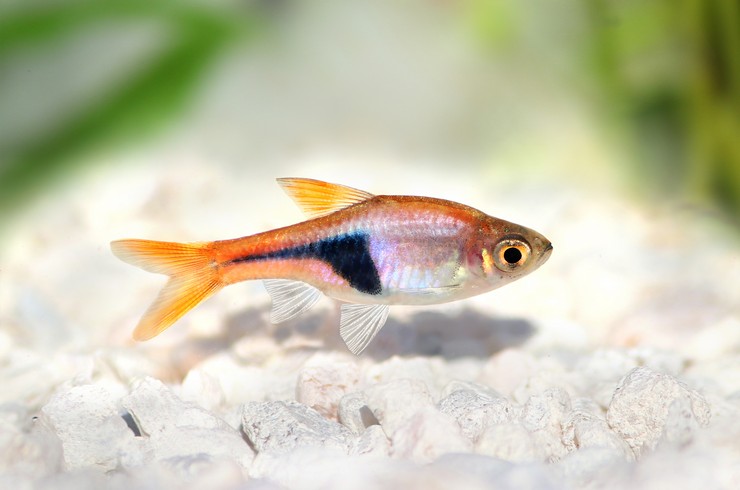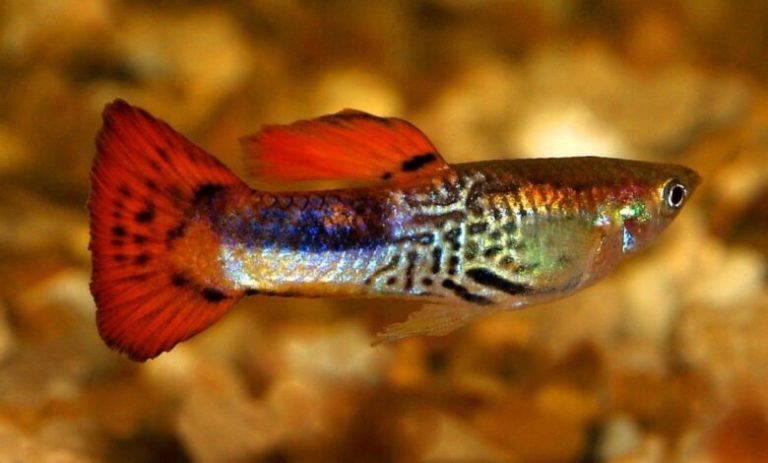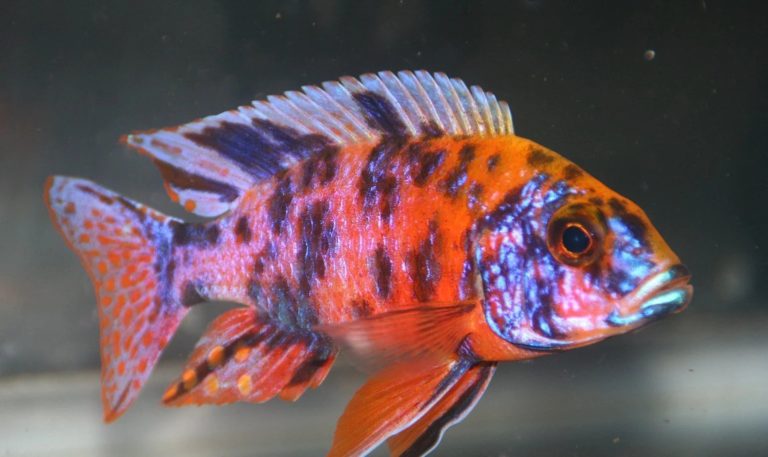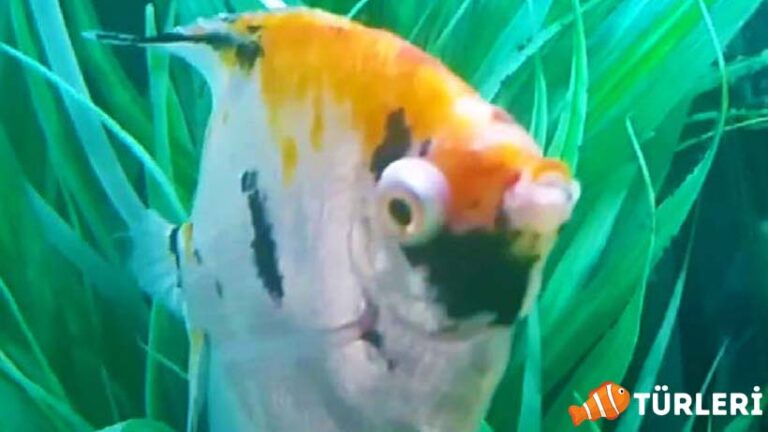Harlequin Rasbora
Harlequin Rasbora (Trigonostigma heteromorpha) is a popular tropical fish species known for its vibrant colors and easy-care requirements. Here’s everything you need to know about keeping Harlequin Rasboras:
Harlequin Rasbora Species Summary:
| Scientific Name: | Trigonostigma heteromorpha |
| Origin: | Freshwater sources of Southeast Asia |
| Diet: | Omnivore (feeds on small invertebrates and plant matter) |
| Behavior: | Peaceful |
| Behavior Towards Their Own Species: | Prefers to be in a school, a group of 6-8 or more is recommended. |
| Swimming Zone: | Middle |
| Water Temperature: | 22 – 28 °C |
| Water Hardness: | 2 – 15 GH |
| pH Level: | 6.0 – 7.5 |
| Minimum Aquarium Volume: | 80 Liters (for a small school) |
| Adult Size: | 4 – 5 cm |
| Reproduction: | They lay eggs on the underside of leaves or on a spawning mop. |
| Lifespan: | 5 – 8 years (with proper care) |
| Care: | Easy to Moderate, requires a well-planted tank, regular aquarium cleaning, and stable water parameters. |
Size
Adult Harlequin Rasboras typically reach a size of about 1.5-2 inches (4-5 cm) in length.
Understanding the size of the fish is essential as it will help in choosing an appropriate tank size, selecting compatible tank mates, and also determining the amount of food to feed them. Their small size makes them suitable for community tanks but be cautious of the tank mates you choose, as larger or aggressive fish can intimidate or even prey on them.
Tank Size
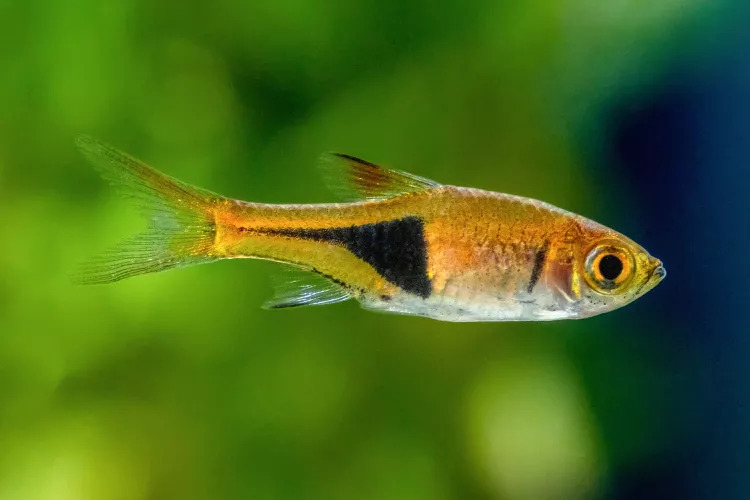
A 20-gallon tank is the minimum size recommended for keeping a small group of Harlequin Rasboras. These fish are schooling fish and prefer to be kept in groups of at least 6-8 individuals. A larger tank will allow for a larger school and more natural behavior.
Harlequin Rasboras are schooling fish, which means they prefer to swim in groups. This behavior is not only for social reasons but also for survival. In the wild, schooling helps them evade predators by creating confusion and making it difficult for a predator to single out an individual fish. In an aquarium setting, schooling fish feel more secure and less stressed when kept in a group. Therefore, it is highly recommended to keep Harlequin Rasboras in a group of at least 6-8 individuals. A larger group will allow for more natural behavior and will also create a more visually appealing display in your aquarium.
Water Parameters
- Temperature: 72-82°F (22-28°C)
- pH: 6.0-7.5
- Hardness: 2-15 dGH
It is crucial to maintain stable water parameters and keep the tank well filtered and clean.
Water quality is one of the most important aspects of fishkeeping. Harlequin Rasboras thrive in warm, slightly acidic to neutral water. Maintaining the water temperature between 72-82°F (22-28°C) is ideal. A heater and a thermometer are essential tools to regulate and monitor the water temperature. Additionally, the pH of the water should be maintained between 6.0-7.5. Regular water testing is necessary to ensure the pH remains within this range. Lastly, the water hardness should be between 2-15 dGH. Soft to moderately hard water is preferred by Harlequin Rasboras.
It is essential to keep the aquarium well filtered and clean. A good quality filter will help remove waste, excess food, and toxins from the water. Regular water changes, approximately 25-30% every two weeks, are also necessary to maintain water quality. During water changes, it is advisable to use a gravel cleaner to remove waste from the substrate. It is also important to treat new water with a water conditioner before adding it to the tank to remove chlorine and other harmful substances.
Aquarium Setup
Substrate and Decorations: Harlequin Rasboras originate from slow-moving streams and rivers with dense vegetation in Southeast Asia. Therefore, it is advisable to replicate their natural habitat as much as possible in the aquarium. A dark substrate will help bring out the vibrant colors of the Harlequin Rasboras. Fine gravel or sand is recommended as the substrate. Additionally, add plenty of live plants, driftwood, and rocks to create hiding spots and mimic their natural environment. Plants like Java Moss, Java Fern, and Anubias are good choices as they are hardy and easy to care for. Floating plants can also be added to provide some shade and reduce stress for the fish.
Lighting and Filtration
Moderate lighting is recommended for an aquarium housing Harlequin Rasboras. Bright lighting can cause stress to the fish, while low lighting may not provide enough light for live plants. An LED light with a dimmer function is a good choice as it allows you to adjust the light intensity. Additionally, a good quality filter is essential to maintain water quality. A hang-on-back filter or an external canister filter are good options for a Harlequin Rasbora tank.
Tank Mates

Harlequin Rasboras are peaceful fish and make great additions to a community aquarium. However, choosing the right tank mates is crucial to ensure a harmonious environment. Here are some suitable tank mates and considerations for keeping Harlequin Rasboras:
- Tetras (e.g., Neon Tetras, Cardinal Tetras): Small and peaceful tetras are excellent tank mates for Harlequin Rasboras. Both species have similar water requirements and are non-aggressive. Their vibrant colors will complement each other and create a visually appealing display.
- Guppies: Guppies are small, colorful, and peaceful fish that can coexist well with Harlequin Rasboras. However, keep in mind that guppies breed prolifically, so it’s essential to have a plan for managing the population.
- Corydoras: Corydoras catfish are bottom dwellers and very peaceful. They will help keep the substrate clean by scavenging for leftover food. Their different swimming levels and temperaments make them compatible with Harlequin Rasboras.
- Small Danios (e.g., Zebra Danios): Small danios are active swimmers and can add movement to the upper levels of the aquarium. They are non-aggressive and can coexist well with Harlequin Rasboras.
- Dwarf Gouramis: Dwarf Gouramis are beautiful and relatively peaceful fish that can be kept with Harlequin Rasboras. However, it’s important to monitor their behavior as some individual gouramis can become territorial.
It is important to avoid keeping Harlequin Rasboras with larger or aggressive fish, such as cichlids or large barbs, as they may become stressed or preyed upon. Also, avoid keeping them with fin-nippers like some species of barbs and tetras, as Harlequin Rasboras have delicate fins.
Other Considerations
- It is advisable to keep Harlequin Rasboras in a well-planted aquarium with plenty of hiding spots. This will provide them with a sense of security and help reduce stress.
- Maintain a stable water temperature and pH level as sudden fluctuations can cause stress to the fish.
- Feeding a balanced diet of high-quality flake food, frozen, or live foods will help keep the fish healthy and vibrant.
- Always observe the behavior of the fish after introducing new tank mates. Some fish may exhibit aggressive behavior that is not typical for their species.
In conclusion, Harlequin Rasboras are peaceful and attractive fish that can be kept with a variety of similarly sized and non-aggressive tank mates. By choosing the right tank mates and providing a suitable environment, you can create a harmonious and visually appealing aquarium.
Diet
Harlequin Rasboras are omnivores, which means they eat both plant and animal matter. A well-balanced diet is essential for their health and well-being.
- High-quality flake or pellet food: Commercially available flake or pellet food designed for tropical freshwater fish is a good staple diet for Harlequin Rasboras. These foods are formulated to provide the necessary nutrients, vitamins, and minerals that the fish need.
- Freeze-dried or frozen foods: In addition to flake or pellet food, it’s important to provide a variety of other foods. Freeze-dried or frozen foods like brine shrimp, daphnia, and bloodworms are excellent choices. These foods are rich in protein and will help keep the fish healthy and vibrant.
- Occasional vegetable matter: While Harlequin Rasboras primarily feed on small invertebrates in the wild, they also consume plant matter. Offering occasional vegetable matter like blanched spinach or zucchini will provide additional nutrients and help keep the fish’s digestive system healthy.
Feeding small amounts 2-3 times a day is recommended. It’s important to only feed what the fish can consume in 2-3 minutes to avoid overfeeding and polluting the water. Remove any uneaten food after feeding to maintain water quality.
- Variety is key: Providing a varied diet is essential for the overall health of the fish. A diet consisting of only one type of food can lead to nutritional deficiencies. Therefore, it’s important to offer a variety of foods to ensure the fish receive all the necessary nutrients.
- Live foods: Live foods like mosquito larvae, micro-worms, and water fleas are also excellent choices for Harlequin Rasboras. These foods mimic their natural diet in the wild and can help stimulate natural feeding behaviors. However, it’s important to source live foods from a reputable supplier to avoid introducing parasites or diseases into the aquarium.
In conclusion, a well-balanced diet consisting of a variety of foods is essential for keeping Harlequin Rasboras healthy and vibrant. High-quality flake or pellet food, freeze-dried or frozen foods, occasional vegetable matter, and live foods should all be included in their diet. Feeding small amounts 2-3 times a day and removing any uneaten food after feeding will help maintain water quality and keep the fish healthy.
Breeding

Breeding Harlequin Rasboras can be a bit challenging, but it is definitely possible with some preparation and careful monitoring. Here are some steps and tips to encourage breeding and raising the fry successfully:
- Set up a separate breeding tank: It is advisable to set up a separate breeding tank to create the optimal environment for breeding and to protect the eggs and fry from being eaten by other fish. The breeding tank doesn’t have to be large; a 10-gallon tank should be sufficient. Fill the tank with slightly acidic water (pH 5.5-6.5) and maintain a temperature of about 80°F (27°C).
- Provide plenty of fine-leaved plants or a spawning mop: Harlequin Rasboras lay their eggs on the underside of leaves. Providing plenty of fine-leaved plants like Java Moss or a spawning mop will give the fish a suitable surface to lay their eggs.
- Condition the breeding pair: Select a healthy pair of mature Harlequin Rasboras (one male and one female) and condition them with high-quality, protein-rich foods like live or frozen brine shrimp and bloodworms for a few days before introducing them to the breeding tank. This will help increase their chances of successful spawning.
- Introduce the breeding pair to the breeding tank: Once the breeding pair is conditioned, carefully introduce them to the breeding tank. Monitor their behavior closely. The male will typically display more vibrant colors and perform a courtship dance to attract the female.
- Remove the parents after spawning: Once the eggs are laid and fertilized, it is essential to remove the parents from the tank as they may eat the eggs. The eggs will typically be laid on the underside of leaves or the spawning mop.
- Incubation period: The eggs will typically hatch in about 24-36 hours, and the fry will become free-swimming in about 3-5 days.
- Feeding the fry: Initially, the fry will feed on the yolk sac. Once they become free-swimming, feed them with infusoria or specially formulated fry food until they are large enough to accept regular foods like baby brine shrimp.
Tips
- Harlequin Rasboras prefer a well-planted tank with plenty of hiding spots.
- Keep the lighting moderate to mimic their natural habitat.
- Maintain a gentle water flow as they come from slow-moving waters in the wild.
- Remember always to acclimate your fish to the new water conditions slowly and monitor them regularly for any signs of stress or disease.
Proper care and maintenance will ensure that your Harlequin Rasboras thrive in your aquarium and may result in successful breeding. Remember that patience and attention to detail are key to breeding any fish species successfully.

